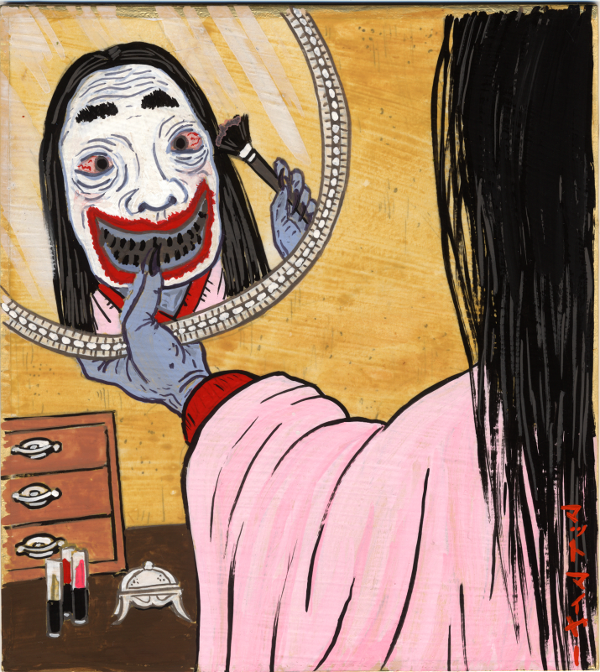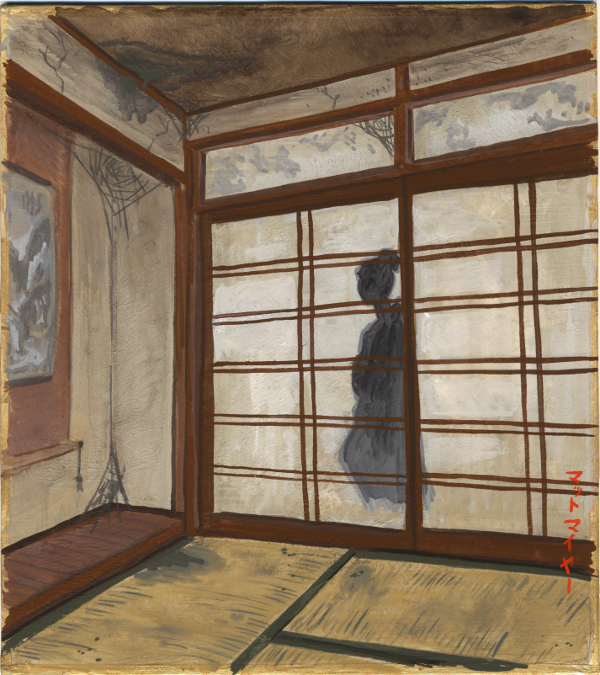
Take-onna
Only about one week left until Halloween! I feel like I have Halloween fever now, having been painting monsters for so long. I’m starting to see yokai in my sleep! Of course, it certainly doesn’t help much that all the while I am painting, I am listening to Halloween web radio or watching horror movies. They say that when you paint, your emotions are imbued into the artwork, and I find that to be true when I am happy or angry or sad… so if I can keep myself at a constant level of scared-ness, that should translate well into my paintings too, right?? Or maybe it will just cause some kind of psychological trauma…
Anyway, I decided to have a bit of fun with today’s yokai and paint her on a different-sized shikishi. This longer shape is called a tanzaku, and I used them last year to paint the five Hyakki Yako panels. Of course, the shape of today’s yokai certainly works nicely on this tall type of board.
Taka-onna
Today’s yokai is another aptly-named one: taka-onna, meaning “tall woman.” (Another reading of her name can be taka-jo, but the meaning is the same.) Her origins are somewhat obscure and come from a few different sources, but in all the stories there are a few key similarities. She appears as a normal woman some of the time, but when she shows her monster form, she elongates her body up to a few meters tall. Her favorite activity in peering into 2nd story windows and scaring whomever is inside. She is always malevolent, and either homely or quite ugly.
Taka-onna is probably most well-known from Toriyama Sekien’s illustration of a woman stretched out to a 2-story-tall height and peeking into a brothel in a red-light district. Like yesterday’s yokai, I guess prostitute monsters were popular in the Edo period. Unfortunately, other than the picture and the name, Sekien tells us nothing at all about her.
Other accounts of taka-onna don’t necessarily put them outside of a brothel, but their actions are basically the same: stretching their bodies like rubber bands and peeking into 2nd story windows.
In one story, a rich farmer notices his 5-year old son has gone missing. He orders his servants to search for him, but over a few days, one-by-one his servants go missing too. Eventually he realizes that his wife is behind the disappearances, as she has been eating the servants! He witnesses her hiding out in his well, and she is able to stretch all the way from the bottom, and out the top. Being a smart farmer, he ran away from the house and never saw her again.
In a few other accounts from other prefectures, she doesn’t do anything harmful other than peeping and being generally creepy.
Anyway, murderous or not, it would certainly cause quite a fright to anyone thinking they were safe and alone on the 2nd floor of their home, when all of a sudden they notice a hideous, haggish woman has been staring at them for who-knows-how-long! |

Take-onna
ハロウィーンまで残すところ後1週間になりました!ずっと妖怪を描き続けてきて夢に妖怪が出てくるようにもなって、なんだかハロウィーン熱に侵されているような感じです。ずっとハロウィーンウェブラジオを聞いて(ハロウィーンシーズンには怖い話をずっと放送するラジオがあります)ホラー映画も見ています。
絵には画家の感情が投影されると言われます。私は自分が楽しい時、悲しい時に描いた絵を見て、なるほどその通りだと実感しました。という事は・・・私が恐怖心を抱き続けられていれば、このプロジェクトの絵は恐怖心を誘う事ができるという事でしょう。どうですか?いや、きっと何かしらの形で心に燻ぶる物になるでしょう・・・。
どちらにしろ、私は今回の妖怪を描くのに少し面白い気持ちをもっています。いつもと違うサイズの色紙に描く、長い姿の高女です。この長い形のものは短冊と呼ばれるもので、昨年5体の百鬼夜行を描いた時にもこれを使いました。もちろん、この短冊は今回の妖怪を描くに適したものだと思います。
Taka-onna
高女の起源ははっきりとしておらず、それにまつわる話もいくつかありますが、それらの言い伝えの中でも共通している部分があります。彼女は普通の女として現れる事もあるけれども、妖怪の姿で現れる時は数メートルの高さにまで伸びているというのです。彼女の好きな事は2階まで伸びあがり部屋を覗き見て部屋の中の人々を怖がらせる事です。彼女はいつでも人の不幸を喜び、質素で薄汚い姿をしているといいます。
鳥山石燕による遊郭で2階の部屋をのぞき見ている高女の絵画はよく知られているでしょう。きっと遊女の妖怪は江戸時代に人気だったのでしょう。しかし残念な事に、その絵と名前以外の事を石燕は私たちに残してくれてはいません。
他の言い伝えでは必ずしも遊郭が登場するわけではありませんが、基本的に体がゴムのように伸びて二階を覗き見るという特徴に変りはないようです。
ある話を一つ紹介しましょう。裕福な農家が、5歳になる息子がいなくなったと気づいて家僕に探してくるよう命じました。しかし日がたつにつれ彼の家僕も一人ずついなくなってしまったのです・・・そして、ついに彼は気づきました。彼の妻が失踪の背後にいるのだと。なんと妻は家僕達を食べていたのです!ある夜彼がこっそりと妻の背後から見張っていると、彼女の胴体はみるみるうちに伸びあがっていったのではないですか。彼は驚いてすぐさま屋敷から逃げ、二度とその女の姿を見ることはなかったのだという・・・。
その他の言い伝えでは、高女はただ覗き見るだけであって人を傷つける事もなくただ気味悪がらせるだけであるとあります。
殺人鬼であろうとなかろうと、2階にいる人々を怖がらせる事には違いないでしょう。醜い女が“どれくらいの長さで”あなたの事をみているだろうか!








